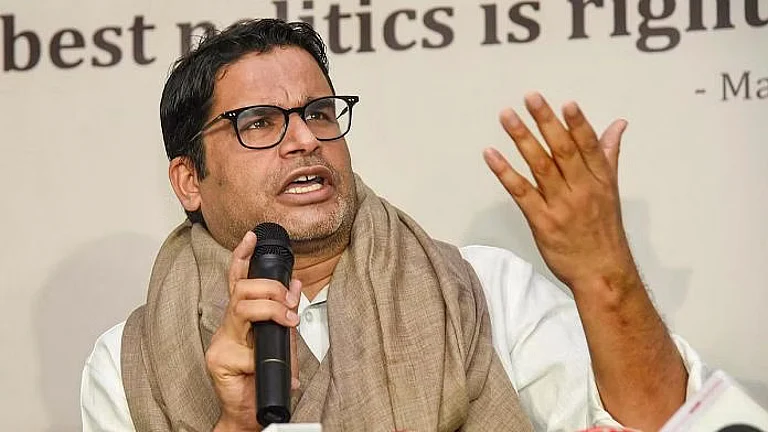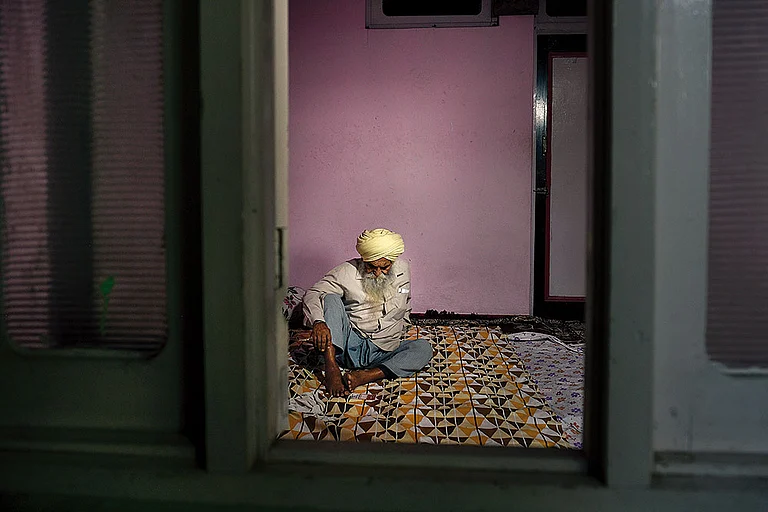At a rally somewhere in Bihar, Rashtriya Janata Dal (RJD) leader Tejashwi Yadav asks the crowd to name the leaders of the ruling Janata Dal (United) in the Rajya Sabha and the Lok Sabha. “Sanjay Jha…Lalan Singh,” the crowd shouts. “Has anyone from the ‘backwards’ and the ‘extremely backwards’ got a decent ministry?” Tejashwi asks. “No,” the listeners reply. Listing the top five ministers in chief minister Nitish Kumar’s cabinet, the RJD leader says none belong to the “extremely backward” category.
EBCs Are Emerging as Bihar’s Decisive Political Force
Loyalty of the extremely backward among the “backwards” or the “maha” Dalit among the Dalits—that’s the crux of the upcoming elections in Bihar
Since October 2, 2023, when the results of the Bihar caste survey showed 63 per cent of the electorate comprised the ‘other backward classes’ (OBCs) and the ‘extremely backward classes’ (EBCs), the castes talked about the most have been the EBCs, who alone account for 36 per cent or 47 million among the state’s 137 million people. According to the 2023 caste survey, the rest of Bihar’s population comprises 19.65 per cent Dalits, 18 per cent Muslims and 15.5 per cent ‘upper’ (dominant, privileged or elite) castes.
Tejashwi’s speeches and the Narendra Modi government’s decision to organise a national caste census—a longtime demand of the Opposition—coming just months before the Bihar election signal the newfound and growing significance of the EBCs, who had long been identified and counted among the OBCs. Yet no prominent political leader has emerged among the EBCs to lead the communities that have so far largely been mobilised in support for Lalu Prasad’s Yadav-led RJD or Nitish Kumar’s Kurmi-led JD(U).
The existence of over 120 subcastes within the EBCs is often blamed for their apparent lack of the political unity that could have enabled strong community leaders to emerge. However, Hitendra Prasad, who belongs to an EBC community, holds the RJD and the JD(U) responsible instead. “Only educational and economic upliftment is not enough,” he says. “Political and social upliftment is also necessary. A few castes such as the Yadavs, Koeris and Kurmis cornered the benefits of OBC reservation. Today, the EBCs are 36 per cent of the population. But do we have 36 per cent representation in government jobs and political parties? Today, the EBCs have to fight with the OBCs for their rights.”
New Prospects for EBC's In The Election Ahead
Hitendra believes there is more awareness in the EBC community today than in the past and it may translate into a new role in the election ahead in terms of political representation. The Bharatiya Janata Party (BJP) has not been able to let Hindutva or nationalist discourse overwhelm the strongly rooted caste equations in Bihar. The caste census is likely the saffron party’s way to reach out to the EBCs, say election analysts.
With the support of the ‘upper’ castes, Dalits and Muslims, the Congress had held on to power for about four decades since Independence, with mostly ‘upper’-caste chief ministers. Jagannath Mishra, S.N. Sinha, Bhagwat Jha Azad, Bindeshwari Dubey—all belonged to the dominant or elite castes. Dalits and the OBCs, with Karpoori Thakur becoming their voice, played a big role in ousting the ‘upper’ castes from authority. Regional parties emerged in the post-Mandal Commission 1990s, and Dalit/OBC leaders with broad popular support came to the forefront. Bihar politics has since revolved around the two big OBC leaders, Lalu Prasad and Nitish, but it was the EBCs who played the most crucial role in catapulting them to the helm.
Bihar politics has revolved around the two big OBC leaders—Lalu and Nitish—but it was the EBCs who catapulted them to the helm.
It was said about Lalu that he used to take the ‘jinn’ (make magic) out of the ballot box. Jinn, colloquially, meant a large chunk of voters and referred to the OBCs who consistently voted for him. Lalu in power spoke for the more marginalised those among OBCs and cultivated their support for a long time. “Lalu was ousted when these communities went over to Nitish,” says election analyst Manikant Thakur. “The EBCs started gaining prominence from the time Nitish separated from Lalu and started the politics of EBCs, which harmed the RJD. If any castes have prevented the RJD from coming to power so far, they are the EBCs.”
Thakur adds that despite taking electoral advantage of these castes, neither Lalu nor Nitish has given them representation in political participation according to their population. The EBCs shifted more towards Nitish when, after coming to power in 2005, he officially divided the OBCs by introducing the category of EBCs. He similarly divided the Dalits by introducing the category of ‘Mahadalit’, and the Muslims by bringing up the category of Pasmandas. Nitish reserved seats for these castes in local body elections. In this way, he made inroads into a large section of the EBCs who had been with Lalu and the Dalits who were with Ram Vilas Paswan. In 2010, the JD(U) got 22.58 per cent of the votes and made history by winning 115 of 243 assembly seats.
Senior journalist Pushyamitra says the fight in Bihar, which used to be between the ‘upper’ and the ‘backward’ castes, gradually since 2005 became one among the backward castes—the OBCs versus the EBCs. Many EBCs drifted away from the RJD because they had to struggle within the OBC category there. “When their numbers came to the fore for the first time in the caste census conducted in Bihar, all parties started trying to woo them,” says Pushyamitra.
“Today, every party is talking about the backward castes, especially the EBCs, because their numbers are the highest. Victory will be easier for whichever party they predominantly vote for. The RJD knows it cannot create a split in the ‘upper’-caste votes. That is why Tejashwi is now openly talking about the backward castes. He is taking Mukesh Sahani along in every programme in order to bring the nine per cent Nishad population to his side through him. If that happens, his alliance’s vote share could exceed 40 per cent, and the number of seats could also increase.”
The Nishads are the largest group after the Yadavs. Citing the number of EBCs as his basis, Sahani has been presenting himself as a potential deputy CM in the Grand Alliance. The last election saw a close contest between the National Democratic Alliance (NDA) and the Grand Alliance or Mahagathbandhan. There was a difference of 15 seats (NDA 125, Grand Alliance 110), but both got a vote percentage of nearly 37.2 per cent, though the NDA led by 0.03 per cent. In such a situation, if a large group of backward castes goes with the RJD, the results could be in favour of the Grand Alliance.
Among the OBCs, both the Yadavs and the Kurmis are considered to be quite prosperous and politically active. Yadavs comprise 14 per cent and Kurmis 2.87 per cent of the electorate. Nitish’s Kurmi community has a relatively smaller population, but he has maintained his political position by forming social and political alliances with the EBCs and the Mahadalits.
RJD leaders say there are many faces from the EBCs in their party, and they will be given opportunities when the time comes. In this election, seat sharing will be based on caste, with a maximum number of candidates being from the EBCs. “Lalu Prasad has given respect and moral strength to all belonging to the EBCs,” says RJD chief spokesperson Shakti Singh Yadav. “If the backward castes are in power today, it is because Lalu Prasad set this narrative. He has brought this change. Today, it is because of Lalu Prasad that Nitish is CM and the BJP is projecting him as its face. They would have sidelined Nitish otherwise, long ago.” Shakti Singh adds that Lalu has strongly established the politics of backward castes in Bihar, due to which the BJP has not been able to come to power till date.
JD(U) national spokesperson Rajiv Prasad Ranjan, however, says Tejashwi “should tell us why a caste census was not conducted in Bihar during the 15-year tenure of his parents (Lalu and mother Rabri Devi)” and “why couldn’t Lalu and the Congress release the caste-based data from the 2011 census?” Ranjan says the NDA conducted the caste census in Bihar and has now decided to conduct it across the country. “As for the EBCs, they know what Nitish has done for them,” he claims.
JD(U) leaders believe that after Nitish’s decisions, a leadership from the EBCs is emerging from the local level and rising to the state and national levels. These days leaders of every caste are displaying their strength in their caste-based rallies across Bihar. Among them, Chirag Paswan and Jitan Ram Manjhi have been prominent faces of Dalits and Mahadalits. However, after their parties broke up, they do not have the same hold as Ram Vilas Paswan used to have. Manjhi’s party’s influence seems limited to two or four seats.
“No one can stop Tejashwi from trying to become a leader, but RJD leaders do not have the credibility and trustworthiness to attract the voters belonging to the backward castes,” says Ranjan. “Under the NDA government, there has been a continuous empowerment of the backward castes. Whether it is reservation in local body elections or government jobs, all this has happened under the NDA government.”
(Translated by Kaveri Mishra)
Md Asghar Khan is senior correspondent from Jharkhand
This article is part of Outlook’s 1 June 2025 issue, 'Gated Neighbourhood', which examines the state of diplomacy, media, and democracy in the wake of the ceasefire. It appeared in print as 'Caste Calculus.'

